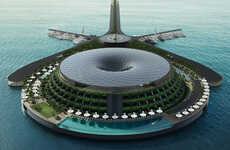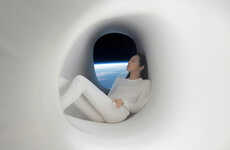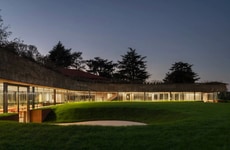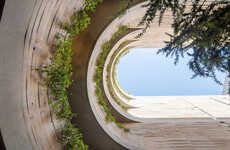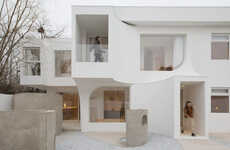
This Hotel Dislocates During Tremors to Prevent Harm from Earthquakes
Margot Krasojevic — December 5, 2016 — Art & Design
References: margot-krasojevic.squarespace & margotkrasojevic.org
This hotel's design and programmatic criteria involves the effects of earthquakes, tremors and dislocations in the immediate environment. Italy has a long history of earthquakes and they are increasing in frequency, so this design was commissioned to contain and reduce the amount of building destruction and fatality as a result of earthquakes in the western province near Naples.
The hotel's plan consists of three separate elements, which move away from each other when tremors are recorded by the hotel's Seismometer. The building elements are constructed from a lightweight aluminium frame, shatterproof glass panels and post-consumer recycled plastic panels, which are strong yet malleable and light, making it easier to move away from neighboring elements and slide along the length of the seismic parallelogram frame which they rest on. Once evacuated, the fabricated panels fold with the frame as it rotates or moves with a tremor. The interior platforms are directly attached to seismic dampers which vibrate but displacement is at a minimum helping with escape routes through the design.
The entire scheme acts as a shock absorber, attaching itself to the landscape as the dampers lock down into the landscape upon the first recording of a seismic movement -- anything above five on the Richter scale is treated as potentially fatal situation and the building responds. The architecture dislocates and breaks apart, reducing the impact of destruction. Early earthquake warning signs include water tray reverberations, with trays positioned around the design that act as both a landscape feature and a tremor detection element, as well as a hotel aviary to indicate an oncoming earthquake.
The architecture is choreographed by the earthquake, responding to the movement and minimizing the impact of the kinetic energy. The software used to develop the design involves simulations in order to understand the effects of dislocations in the landscape.
The hotel's plan consists of three separate elements, which move away from each other when tremors are recorded by the hotel's Seismometer. The building elements are constructed from a lightweight aluminium frame, shatterproof glass panels and post-consumer recycled plastic panels, which are strong yet malleable and light, making it easier to move away from neighboring elements and slide along the length of the seismic parallelogram frame which they rest on. Once evacuated, the fabricated panels fold with the frame as it rotates or moves with a tremor. The interior platforms are directly attached to seismic dampers which vibrate but displacement is at a minimum helping with escape routes through the design.
The entire scheme acts as a shock absorber, attaching itself to the landscape as the dampers lock down into the landscape upon the first recording of a seismic movement -- anything above five on the Richter scale is treated as potentially fatal situation and the building responds. The architecture dislocates and breaks apart, reducing the impact of destruction. Early earthquake warning signs include water tray reverberations, with trays positioned around the design that act as both a landscape feature and a tremor detection element, as well as a hotel aviary to indicate an oncoming earthquake.
The architecture is choreographed by the earthquake, responding to the movement and minimizing the impact of the kinetic energy. The software used to develop the design involves simulations in order to understand the effects of dislocations in the landscape.
Trend Themes
1. Seismic-resistant Architecture - Opportunities for designing buildings that can displace and slide during earthquakes to minimize damage and save lives.
2. Innovative Building Materials - Opportunities for developing lightweight and strong materials for seismic-resistant architecture, such as recycled plastic panels.
3. Simulation-based Design - Opportunities for using software simulations to understand the effects of dislocations in landscapes and develop earthquake-resistant designs.
Industry Implications
1. Hospitality and Tourism - Opportunities for hotels and resorts in seismic-prone areas to invest in seismic-resistant architecture to ensure guest safety and protect their assets.
2. Construction - Opportunities for construction companies to specialize in seismic-resistant design and provide consultation services to clients in earthquake-prone areas.
3. Environmental Sustainability - Opportunities for environmental sustainability industries to develop and promote the use of post-consumer recycled materials in seismic-resistant architecture.
6.4
Score
Popularity
Activity
Freshness

